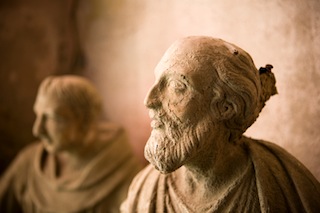 I spend a lot of time talking about evolutionary blueprints, primordial logic and genetic instinct because I happen to think there’s value in it. We live today with the belief (or maybe bluster) that we’re “evolved” beyond our evolution. Too often there’s a resistance to scrutinize our innate responses to the world, to question our choices or to imagine that what we want to pursue is anything other than deep and enlightened rationality at its finest. Sometimes people are offended by the concept of seeing themselves as products of their evolution. For some people, it’s the equivalent of calling them advanced animals, to which I basically agree (much to their continuing exasperation). And, yet, there’s the crux of our human story – these additional, incredible capabilities that we can access and use to guide our lives. These capacities over the millennia have impressively flowered into everything from science to art to, most notably for today’s post, life philosophy.
I spend a lot of time talking about evolutionary blueprints, primordial logic and genetic instinct because I happen to think there’s value in it. We live today with the belief (or maybe bluster) that we’re “evolved” beyond our evolution. Too often there’s a resistance to scrutinize our innate responses to the world, to question our choices or to imagine that what we want to pursue is anything other than deep and enlightened rationality at its finest. Sometimes people are offended by the concept of seeing themselves as products of their evolution. For some people, it’s the equivalent of calling them advanced animals, to which I basically agree (much to their continuing exasperation). And, yet, there’s the crux of our human story – these additional, incredible capabilities that we can access and use to guide our lives. These capacities over the millennia have impressively flowered into everything from science to art to, most notably for today’s post, life philosophy.
The truth is, we’re heavily influenced by the impulses of our evolutionary wiring, but that doesn’t mean we’re helpless against them. Our lucky species developed a reflexive thinking capacity – the ability to observe our own mental states, our own cognitive processes and emotional responses. In short, we can – when we’re willing – observe our own thoughts and motivations with a degree of objectivity.
So, while our primal inclinations are always a factor, they aren’t the only factor – or even necessarily the voice that wins out. In this context, the benefit of understanding our evolutionary default is that we don’t have to do it all the time. We have more options – and can consciously distinguish the underlying sources of our choices.
The Importance of a Life Philosophy
Although I’ve always been a science guy, I’ve found myself drawn to philosophy at times. For the most part, I take a pretty practical approach to it. I want something I can use. Navel gazing doesn’t interest me, and neither does splitting hairs or playing a game of clever semantics. Philosophy, as I appreciate it, isn’t an academic study but a useful template (or choice of templates actually) for life practice.
 Recently, I enjoyed a great read for this purpose: A Guide to the Good Life: The Ancient Art of Stoic Joy by William B. Irvine. It’s a thoughtful but readable primer for understanding and practicing Stoicism, the branch of Hellenistic philosophy cultivated over the span of a few hundred years by figures like Zeno of Citium, Diogenes, Cato, Epictetus, Seneca and Marcus Aurelius, although shadows of Stoic philosophy would pop up now and then among the works of famous figures and movements into the 19th Century.
Recently, I enjoyed a great read for this purpose: A Guide to the Good Life: The Ancient Art of Stoic Joy by William B. Irvine. It’s a thoughtful but readable primer for understanding and practicing Stoicism, the branch of Hellenistic philosophy cultivated over the span of a few hundred years by figures like Zeno of Citium, Diogenes, Cato, Epictetus, Seneca and Marcus Aurelius, although shadows of Stoic philosophy would pop up now and then among the works of famous figures and movements into the 19th Century.
Irvine begins by asking us to consider our primary objective in life – the goal which takes precedence over all others, the goal which all our interests should ideally serve. He challenges us to think “what we want out of life” not in the short-term or even in decade-oriented aims but as the overarching pursuit we attach to our lives. Only when we identify this, he says, can we have a “coherent life philosophy.”
Living in alignment with this ideal is the crux of the “good life.” The Stoics – and Irvine’s book as a reflection of their interests – both define a good life and strategize for it.
It’s a cause that intrigued me and that touches on the purpose of the Primal Blueprint as I see it – how to live the healthiest, happiest life with the least amount of pain, suffering and sacrifice.
It’s why I wrote both The Primal Blueprint and, later, The Primal Connection – as a response to the restless, discontent, searching condition in which many of us find ourselves. What is the reality behind the modern ennui, midlife crises and end-of-life regrets many experience? And so that all-too-common question of personal satisfaction (or dissatisfaction) intersects with that of life purpose: Is this all there is?
At issue here is the threat of “misliving” our lives, which according to Irvine, is more likely than ever. As he explains, most people “spend their days working hard to be able to afford the latest consumer gadget, in the resolute belief that if they only buy enough stuff, they will have a life that is both meaningful and maximally fulfilling.” Sound familiar?
He implicates evolutionary programming, what he considers the culprit behind our “assiduously seeking out what feels good and avoiding what feels bad.” Personally, I see our evolutionary blueprint in a more complex light, with implications for social altruism and even duty, which he highlights as a Stoic principle. Nonetheless, I believe he’s correct that our evolutionary instincts do steer us more toward situational response than overarching purpose.
While the modern age is full of life-wasting distraction, it simultaneously offers us an historically unique opportunity for more people to make the most of their years – to decide where instinct will have its way and where some greater vision will guide them.
Defining “The Good Life”
This good life, according to Irvine, varied in detail among the individual philosophers but as a whole hovered most consistently around the concept of “tranquility,” the experience of relative peace and satisfaction in light of nearly any condition. The ultimate goal, as Irvine describes, is “to make [our] happiness depend as little as possible on [our] external circumstances.”
And, yet, it also seeks to maximize joy while limiting detriment. As Irvine explains, it’s an “enlightened hedonism,” with which we seek and enjoy pleasure but simultaneously attempt to conquer our Desire (with a capital D rather than a particular desire). It’s about developing – through discipline – an unshakable equilibrium through which we can gain the most from our lives and give as little to distraction and dead ends as possible. When we are no longer ruled by our “tendency toward insatiability,” we are able to experience fulfillment at a deeper, more substantial and satisfying level.
The result is, as Irvine puts it, “less comfort and pleasure, but considerably more joy.” It’s a discipline that minimizes our valuing of the external possessions and situations, maximizes our cultivation of our internal capacities and obliges us to live from greater appreciation for the relationships and experiences that fulfill us.
Materialism, vanity and indulgence, they warned, are the surest ways to “mislive” our lives and are the most likely to result in regret. We do better to master ourselves, they believed, and live a life larger than chasing our instinctual insatiability. According to Stoic thought, we’re better off and more likely to experience long-term, sustainable joy and contentment with a sense of purpose, a priority of self-control and a belief in tranquility above all else.
At various points he asks us to compare the situations of those who know or care nothing of a Stoic perspective with those who practice this philosophy. While it’s impossible to do justice to all of what he illuminates about Stoic thinking, consider these points.
In Matters of Emotional Influence…
Do we want to hold on to anger, to use it as a motivation, to allow a sensitivity to take root in ourselves that makes the slightest provocation feel dramatic? Can we let go of anger as a waste of precious life and even contemplate with humility our own annoying natures?
Can we believe that grief has a purpose but that it can also pass? Can we believe that at some point reason can speak to grief and help us reenter life beyond it?
In Matters of Material Wealth…
Can we see how desire for and attachment to money or material goods can cause us to sacrifice experiences, to compromise relationships, and to make choices that do not serve our greater happiness – the kind that in our final days we will take ultimate comfort in? Do we see how acquisition can never lead to contentment but simply perpetuates the cycle of desire and may keep us from appreciating small joys?
Can we accept living with the likelihood of more modest means because we choose not to prioritize acquisition or exertion that compromises other areas of our happiness and tranquility? If wealth does, by happenstance, come our way, can we live in detachment from it?
In Matters of Social Standing…
Can we accept that valuing the opinion of others can enslave us? Do we feel truth behind Epictetus’s saying, “‘What upsets people is not the things themselves but their judgments about those things?’”
Is it possible for us to envision a life in which we are indifferent to what others think of us while still caring for those we are closest to? Do we believe in the impact of selectively socializing with those who share our basic values? Can we relate with boundaries that allow us, above all, to remain true to ourselves?
In Matters of Control…
Can we not only intellectually embrace Irvine’s adaptation of Epictetus’s theory – a “trichotomy of control” (what we have total control over, what we have some control over, what we have no control over) and apply it to our everyday choices? Can we commit above all to cultivating the best in ourselves? Can we stick by a primary desire to “not be frustrated by forming desires [we] won’t be able to fulfill”?
Can we accept a middle ground that encourages us to engage in processes we find valuable in and of themselves, investing insomuch as the process itself (e.g. for health, well-being, professional development) fulfills us – but letting go of “bigger” outcomes?
In Matters of Physical Comfort/Denial…
Can we see value in keeping ourselves a little uncomfortable at times? Can we accept forgoing pleasure to a certain point in order to avoid feeling entitled to it all the time? How can we embrace cultivating mental fortitude and physical resilience?
In Matters of Aging…
Do we believe that life is supposed to always go our way – especially when we do everything “right”? Or do we see the sense in cultivating an acceptance of circumstances for the sake of tranquility? Even though we invest in making our later years as vital as possible, can we be satisfied without our desired outcome?
How do we respond to Seneca’s thought, “Let us cherish and love old age: for it is full of pleasure if one knows how to use it”?
In Matters of Death…
How much are we willing to invest in our overarching goal and committing to a life philosophy designed to leave us without regret in our last days? How do we feel about a “good death“? Do we live with purpose and even believe in causes worth dying for?
What Does It Mean to Become a Primal Stoic?
All this said, what does this mean for a Primal Blueprinter? How does one make the connection between primeval and ancient – and go on to practice a Primal Stoicism?
Just as I claim to merely be an interested explorer on this path, I think the question is open to wide interpretation. Maybe you already have some ideas or questions you’d like to propose on the comment board.
But here’s what I think – and let me add a bit about the primary points that Irvine highlights.
The “single most valuable technique” in practicing Stoic philosophy as Irvine sees it is negative visualization. (I can just hear the energy and manifesting folks gasp.) I’ll acknowledge I was a bit skeptical initially, but stay with me and see what you think.
According to the Stoics, we should regularly visualize negative occurrences – losing our possessions, losing our faculties, even losing those we love – in order to not take them for granted. We don’t have to stay there long, but in imagining these scenarios, we can practice detachment from what fills our lives. We can forestall or reverse, as Irvine explains, the natural “Hedonic adaptation” that causes us to get bored with the various elements, possessions and people in our lives. Without requiring a blatant “catastrophe,” we can remedy the ennui and “jadedness” that too often sets into our minds and, as a result, live and act each day with greater appreciation for all we have. In its proper perspective, I think this tactic (as a thoughtful practice and not a fear-based obsession) is brilliant.
In the end, however, what draws me most to this book and to the Stoic perspective is the focus on and acceptance of what is. It’s about being present to our lives – each moment – no matter what.
This might surprise a few folks who see me as a chronic do-er always in search of the next ambitious development. That’s true, too. But there’s a difference – especially in the last decade or so for me.
While the Stoics themselves wouldn’t likely call me a fitting poster child for their movement, I believe in the primacy of reason and see it as the formidable and natural counterpart to evolutionary logic – when interpreted correctly.
I believe in the power of letting go of outcomes. I commit only to projects where the process itself is worth my time, energy and enthusiasm even if the outcomes end up miserable failures. This way, I know I haven’t wasted my personal investment, which I view as separate from any monetary input.
I believe in gratitude as a discipline. I’ve seen it firsthand in people who have almost nothing, and those experiences have had their sway. Entitlement never did anyone any favors, and we moderns (in the more affluent subsections of the so-called first world) I think have to consciously battle this mental and cultural pest. An infestation of entitlement has the power to undermine and even level lives in a way hardship doesn’t. The best way I’ve found to take on the lulling patterns in which we take what we have for granted is to regularly remind myself of their impermanence. It’s all on loan, and seeing it as such helps me appreciate all I have today.
Finally, it’s how this sense of impermanence and this prioritization of small, present joys connects with the immediacy of our primal ancestors’ reality that intrigues me. To live a life where value resides in the here and now – and to embrace it, discover it, every day as a deliberate life vision ultimately feels like the best of both philosophical worlds.
Thanks for reading, everyone. What thoughts came up for you as you read through? Do you connect your Primal perspective with another philosophy to guide your life and choices – and how so? Have a great end to your week.
SOURCE: Mark’s Daily Apple – Read entire story here.





